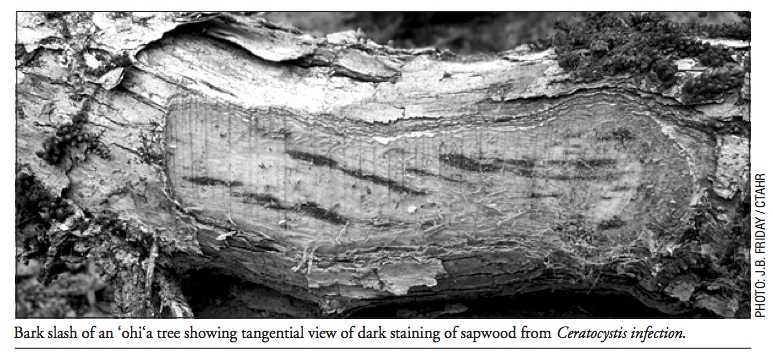The rapid spread of the fungus killing `ohi`a on the Big Island is scary enough. The prospect that it could take down `ohi`a on other islands is a nightmare.
How to stop it at the shores of Hawai`i island was the question on the minds of most members of the Coordinating Group on Alien Pest Species when it met last month.
“Do we have enough information to try to work on some sort of emergency rule?” asked Christy Martin, CGAPS director. “Probably not is my guess,” she said, answering her own question.
An emergency rule from the Plant Quarantine Branch of the state Department of Agriculture (DOA) could put a ban on the shipment of `ohi`a – seedlings for nursery stock, logs for firewood, and all other `ohi`a products – from Hawai`i island to other sites within the state.
Amy Takahashi, the acting manager of Plant Quarantine, was asked to tell the group what kind of information would be needed before such an inter-island quarantine could be effected.
“Plant Quarantine is responsible for setting up emergency rules to place restrictions on the movement of `ohi`a as well as other known hosts,” she said. “But we need to have the science to back it up.”
Also, she said, “we have to have an option for treatment. We can’t put a total ban on the transfer. … There needs to be a way for these commodities to move or of saying that certain items will be low risk.”
In addition to finding a treatment, knowing how the fungus, Ceratocystis fimbriata, is spread, identifying its possible hosts (in addition to `ohi`a), and determining its longevity in dead wood were all mentioned as areas of research that would need to be addressed before an emergency rule could be put into place.
Later in the meeting, however, Takahashi was challenged on her insistence that treatment options had to be available before a quarantine could be imposed.
During the discussion of the coconut rhinocerous beetle, which so far has been found only on O`ahu, Springer Kaye of the Big Island Invasive Species Committee said that Neil Reimer, acting administrator of the DOA’s Plant Industry Division, had promised that a rule addressing the beetle would be issued soon. In the meantime, she was concerned, she said, that a business on O`ahu was continuing to ship mulch to Lana`i – mulch that could easily be hiding beetle eggs or larvae.
Chris Kishimoto, an entomologist with the DOA, responded. “One of the main reasons why it’s not going through the interim rule process is because right now we have no treatments. We can’t prohibit the movement of a commodity just because there’s a pest. We have to have treatment options to allow those commodities to move.”
Instead of a rule, he continued, “we’re looking at doing compliance agreements and hope we’ll have that ability in the near future.”
Kaye was not satisfied. “There’s absolutely no way to screen mulch in any that’s at all effective. I want to state my strong protest on this idea that we’re delaying something. I disagree with the decision to not quarantine what we can.”
Teya Penniman of the Maui Invasive Species Committee followed up with a challenge on the very claim that a treatment option has to be available before an emergency rule can be implemented.
“What statute says there has to be a treatment option?” she asked.
Takahashi’s reply took many in the room aback.
“There’s no requirement that says you have to have it,” she said. When the DOA takes a proposed rule to public hearings, she said, “what we find out, even though there’s good science that says we need to restrict the movement of pests, the other side is, we need to have businesses be able to move their items as needed. … Treatment with chemicals, fumigation, even heat treatment, to minimize infestation and allowing [goods] to move has always been a practice for us before we establish interim or permanent rules. So it’s just a practice, not policy.”
Meanwhile, `Ohi`a Rust Rule Waits
It has been ten years and counting since Puccinia psidii was first identified as a threat to `ohi`a. In February, the Board of Agriculture voted to allow a permanent ban on imports of potential carriers of this rust, meaning that the department could now take the rule to public hearings.
At the CGAPS meeting, Takahashi updated the group on the timeline for adopting a final rule. “We need to go to the board in June, … do amendments, followed by governor approval. Then hearings, probably in the summertime, finalize it in the fall.”
— Patricia Tummons



Leave a Reply